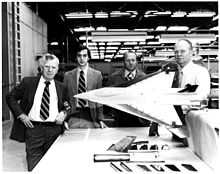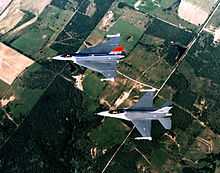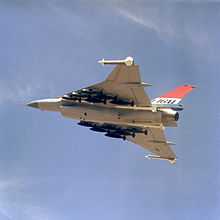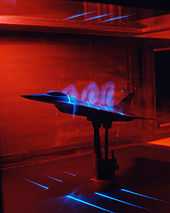General Dynamics F-16XL
| F-16XL | |
|---|---|
 | |
| F-16XL in flight | |
| Role | Experimental fighter |
| Manufacturer | General Dynamics |
| First flight | 3 July 1982 |
| Primary users | United States Air Force NASA |
| Number built | 2 |
| Developed from | General Dynamics F-16 Fighting Falcon |
The General Dynamics F-16XL is a derivative of the F-16 Fighting Falcon, with a cranked-arrow delta wing. It was originally conceived as a technology demonstrator, later entered in the United States Air Force's (USAF) Enhanced Tactical Fighter (ETF) competition but lost to the F-15E Strike Eagle. Several years after the prototypes were shelved, they were turned over to NASA for additional aeronautical research.
Development
SCAMP

In 1977, the F-16XL started out as the F-16 SCAMP (Supersonic Cruise and Maneuver Prototype) at General Dynamics Fort Worth. Under the leadership of Harry Hillaker (father of the original F-16), the original goal of the program was to be a quick project to demonstrate the applicability of supersonic transport technologies to military aircraft.[1] The big wing generated a lot of lift, and typical aerodynamic limitations of delta wings were overcome by the F-16's relaxed static stability. The F-16's electronic flight control system was tweaked to allow control at high angles of attack. The wing was also a big fuel tank which greatly boosted range. The study went on for two years. The goal of the cranked arrow was to have a high sweep inboard panel for low drag at supersonic speeds, and a low sweep outboard panel to provide better handling and maneuverability at subsonic speeds.
Working closely with NASA's Langley Research Center, the company invested significant Internal Research and Development (IRAD) funds for wind tunnel testing and that led to the Model 400. It featured all moving wing tips for roll control and an all moving vertical tail. These surfaces were actually the horizontal tail surfaces from the F-16A. These surfaces were later dropped as they did not provide adequate control at low speed, high angle of attack. Also, there would have been no provision for wing-tip mounted missiles. The main wing incorporated forebody strakes to enhance vortex generation for high angle of attack maneuverability, negative stability for improved subsonic lift and reduced supersonic drag. It was built around a 40-inch fuselage stretch. Both the large wing and fuselage stretch yielded a dramatic increase in range at all speeds. In 1979, with a strong positive response by the USAF, GD released the Model 400 for a company funded preliminary design effort.[2]
Enhanced Tactical Fighter competition

In 1980, the USAF signed on as a partner, providing the third and fifth production F-16 airframes for conversion. These two airframes became the only examples of the F-16XL.
In March 1981, the USAF announced the Enhanced Tactical Fighter program to procure a replacement for the F-111 Aardvark. The concept envisioned an aircraft capable of launching deep interdiction missions without requiring additional support in the form of fighter escort or jamming support. Under the leadership of program director Randy Kent , General Dynamics submitted the F-16XL, while McDonnell Douglas submitted a variant of the F-15 Eagle. Though the two aircraft were competing for the same role, they were fairly different in design approach. The F-15E is basically an F-15D two-seat trainer with the back-seat station modified to support ground-attack instruments, while the F-16XL has major structural and aerodynamic differences from the original F-16. As such, the XL would have required much more effort, time and money to put into full production. Additionally, the Strike Eagle has two engines, which gives it more thrust and capacity to carry more weapons and/or armor. Furthermore, engine redundancy can be very useful for an aircraft whose mission involves operating within the reach of anti-aircraft artillery and surface-to-air missiles, in addition to the standard threats of fighter aircraft and interceptors.
In February 1984, the USAF awarded the ETF contract to McDonnell Douglas. The two F-16XLs were returned to the Air Force and placed in storage at Edwards Air Force Base, Mojave, California.
Design

The wing and rear horizontal control surfaces were replaced with a cranked-arrow delta wing 120% larger than the original wing. Extensive use of carbon fiber composites allowed the savings of 600 lb (270 kg) of weight but the F-16XL was still 2,800 lb (1,300 kg) heavier than the original F-16A.
Less noticeable is that the fuselage was lengthened by 56 in (1.4 m) by the addition of two sections at the joints of the main fuselage sub-assemblies. With the new wing design, the tail section had to be canted up 3°, and the ventral fins removed, to prevent them from striking the pavement during takeoff and landing. However, as the F-16XL exhibits greater stability than the native F-16, these changes were not detrimental to the handling of the aircraft.
These changes resulted in a 25% improvement in maximum lift-to-drag ratio in supersonic flight and 11% in subsonic flight, and a plane that reportedly handled much more smoothly at high speeds and low altitudes. The enlargements increased fuel capacity by 82%. The F-16XL could carry twice the ordnance of the F-16 and deliver it 40% farther. The enlarged wing allowed a total of 27 hardpoints:
- 16 wing stations of capacity 750 lb (340 kg) each
- 4 semi-recessed AIM-120 AMRAAM stations under fuselage
- 2 wingtip stations
- 1 centerline station
- 2 wing "heavy/wet" stations
- 2 chin LANTIRN stations
However, the "heavy/wet" stations interfered with up to four wing stations.
Operational history
NASA testing
_in_flight_060905-F-1234S-049.jpg)
In 1988, the two aircraft were taken out of storage and turned over to NASA for research. The first aircraft was fitted with an active suction titanium glove encasing the left wing and delivered to the Ames-Dryden Flight Research Facility at Edwards AFB. Designed and built by North American Aviation (a division of Rockwell International), the glove had laser-cut holes that were nominally 0.0025 in (0.0635 mm) diameter. Distance between holes varied between 0.010 and 0.055 in (0.25 and 1.40 mm) depending on the suction. The glove covered over 5 ft² (0.5 m²) of the wing. It was intended to suck away turbulent airflow over the wing, restoring laminar flow and reducing drag. The aircraft was also involved in testing sonic boom characteristics, takeoff performance, and engine noise, for NASA's civil transport program.
The second aircraft (a two-seater) had its experimental engine replaced with a General Electric F110-129. It accidentally achieved supercruise, a design goal of the F-16XL that was never attained in ETF testing, when it reached Mach 1.1 at 20,000 ft (6,096 m) on full military power. It was mounted with a passive fiberglass and foam glove on the right wing to examine supersonic flow, and an active glove on the left wing. This second glove was composed of fiberglass and foam over a titanium skin, and covers 75% of the wing's surface and 60% of its leading edge. The active portion consists the middle two-thirds of the glove, with laser-drilled holes leading to cavities beneath the wing. It was designed collaboratively by Langley research center, Dryden, Rockwell, Boeing, and McDonnell Douglas. The glove is intended as a testbed for supersonic laminar flow.
The F-16XL flight project office was located at the NASA Dryden Flight Research Center, Edwards AFB, CA. The NASA Langley Research Center, developed and coordinated F-16XL experiments.[3]
At the conclusion of their test programs in 1999, both F-16XLs were placed into storage at NASA Dryden. In 2007, NASA approached Lockheed Martin to request a study into the feasibility and cost of returning F-16XL #1 to flight status and upgrading it with many of the improvements found in the USAF's F-16 Block 40. This was studied while F-16XL #1 was taxi tested at Dryden and given systems checks. However, both F-16XLs were retired in 2009 and stored at Edwards AFB.
Specifications (F-16XL number 2)


Data from Darling[4] F-16.net[5]
General characteristics
- Crew: One (XL #1) or Two (XL #2)
- Length: 54 ft 2 in (16.51 m)
- Wingspan: 34 ft 3 in (10.44 m)
- Height: 17 ft 7 in (5.36 m)
- Wing area: 646 ft² (60.0 m²)
- Empty weight: 22,000 lb (9,980 kg)
- Loaded weight: 48,000 lb (21,800 kg)
- Max. takeoff weight: 48,000 lb (21,800 kg)
- Powerplant: 1 × General Electric F110-GE-100 turbofan
- Dry thrust: 17,100 lbf (76.3 kN)
- Thrust with afterburner: 28,900 lbf (125 kN)
Performance
- Maximum speed: Mach 2.05 (1,400 mph, 698 m/s)
- Cruise speed: 600 mph (268 m/s)
- Range: 2,480 nmi (2,850 mi, 4,590 km)
- Service ceiling: 50,000 ft (15,000 m)
- Rate of climb: 62,000 ft/min (320 m/s)
Armament
- Guns: 1 × 20 mm (0.79 in) M61 Vulcan (Gatling) gun
- Hardpoints: 17 pylons with a capacity of up to 15,000 lb (6,800 kg) of payload
See also
- Related development
- Aircraft of comparable role, configuration and era
- Related lists
References
Citations
- ↑ "SCAMP". NASA. Retrieved 2009-02-22.
- ↑ "Harry Hillaker, father of the F-16". Code one. General Dynamics. July 1991. Retrieved 2009-02-22.
- ↑ "F-16XL". NASA. Retrieved 2009-02-17.
- ↑ Darling 2003, pp. 63, 64, 69.
- ↑ "F-16 XL, Cranked-Arrow Wing", F-16, retrieved 18 April 2009.
Bibliography
- Darling, Kev (2003), F-16 Fighting Falcon, Combat Legend, London: Airlife, ISBN 1-84037-399-7.
- Jenkins, Dennis R; Landis, Tony R (2008), Experimental & Prototype US Air Force Jet Fighters, MN, US: Specialty, ISBN 978-1-58007-111-6.
External links
| Wikimedia Commons has media related to General Dynamics F-16XL. |
- "F-16XL", DFRC (photo gallery) 1, NASA, photo gallery number 2
- F-16XL experiment report (PDF), Dryden: NASA, December 1999.
- "The Revolutionary Evolution of the F-16XL", Air Force magazine, November 1983.
- "NASA Could Put The F-16XL Back In The Air", Flight International (Flight global), 2007.
- "Harry Hillaker — Father of the F-16", Code one, Jul 1991
- Baugher, Joseph ‘Joe’, F-16XL, ATT
| ||||||||||||||||||||||||||||||
| ||||||||||||||||||||||